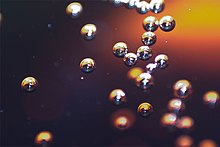Effervescence
This articleneeds additional citations forverification.(November 2021) |

Effervescenceis the escape of gas from anaqueous solutionand the foaming or fizzing that results from that release.[1]The word effervescence is derived from theLatinverbfervere(to boil), preceded by the adverbex.It has the same linguistic root as the wordfermentation.[citation needed]
Effervescence can also be observed when opening a bottle of champagne, beer or carbonated beverages such as some carbonatedsoft drinks.The visible bubbles are produced by the escape from solution of the dissolved gas (which itself is not visible while dissolved in the liquid).
In beverages
[edit]Although CO2is most common for beverages,nitrogen gasis sometimes deliberately added to certain beers. The smaller bubble size creates a smootherbeer head.Due to the poor solubility of nitrogen in beer,kegsorwidgetsare used for this.[2]
Chemistry
[edit]In the laboratory, a common example of effervescence is seen ifhydrochloric acidis added to a block oflimestone.If a few pieces ofmarbleor anantacidtablet are put in hydrochloric acid in atest tubefitted with abung,effervescence ofcarbon dioxidecan be witnessed.
- CaCO3+ 2 HCl → CaCl2+ H2O + CO2↑
This process is generally represented by the followingreaction,where a pressurized dilute solution ofcarbonic acidin water releases gaseous carbon dioxide atdecompression:
- H2CO3→ H2O + CO2↑
In simple terms, it is the result of the chemical reaction occurring in the liquid which produces a gaseous product.[3]
See also
[edit]- Cavitation
- Carbonation
- Effervescent tablet
- Precipitation (chemistry),the "down-arrow"
References
[edit]- ^"Effervescence".Archived fromthe originalon 2007-06-09.Retrieved2010-04-14.
- ^Baxter, E. Denise; Hughes, Paul S. (2001).Beer: Quality, Safety and Nutritional Aspects.Royal Society of Chemistry. p.22.ISBN9780854045884.
nitrogen gas beer
- ^G. Liger-Belairet al.,"Study of Effervescence in a Glass of Champagne: Frequencies of Bubble Formation, Growth Rates, and Velocities of Rising Bubbles",Am. J. Enol. Vitic.50:3 (1999), 317–323.
